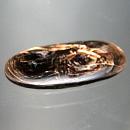|
|
||||||||||||||||
|
||||||||||||||||
|
||||||
|
|
|
|
Phlogopite
|
|
| | |
| Discovered in 1841; IMA status: Valid (IMA Approved 1988) | ||
|
| ||
|
Chemistry |
|
|
| |
|
KMg3AlSi3O10(OH,F)2 | |
|
|
Potassium Magnesium Aluminum Silicate Hydroxide Fluoride |
|
Molecular Weight: |
419.25 gm |
|
Composition: |
Potassium |
9.33 % |
K |
11.23 % |
K2O |
|
|
Magnesium |
17.39 % |
Mg |
28.84 % |
MgO |
|
|
Aluminum |
6.44 % |
Al |
12.16 % |
Al2O3 |
|
|
Silicon |
20.10 % |
Si |
42.99 % |
SiO2 |
|
|
Hydrogen |
0.24 % |
H |
2.15 % |
H2O |
|
|
Oxygen |
41.98 % |
O |
|
|
|
|
Fluorine |
4.53 % |
F |
4.53 % |
F |
|
|
|
- % |
F |
-1.91 % |
-O=F2 |
|
|
|
100.00 % |
|
100.00 % |
= TOTAL OXIDE |
|
|
|
||||
|
Classification |
|
|
| |
|
Silicates (Germanates) | |
|
8/H.11-80 | |
|
|
9 : SILICATES (Germanates)
|
|
Related to: |
Mica Group. Biotite-Phlogopite Series. The hydroxyl analogue of Fluorophlogopite and the magnesium analogue of Hendricksite. Also, generally the micas on the Phlogopite end (magnesium end) of the Biotite-Phlogopite Series, including Phlogopite, Fluorophlogopite, Eastonite, and Hendricksite. |
|
Members of Group: |
Mica Group: Aluminoceladonite, Anandite, Annite, Annite-Phlogopite Series, Aspidolite, Balestraite, Biotite, Bityite, Boromuscovite, Brammallite, Celadonite, Chernykhite, Chromceladonite, Chromphyllite, Clintonite, Eastonite, Ephesite, Ferroaluminoceladonite, Ferroceladonite, Ferrokinoshitalite, Fluorannite, Fluorphlogopite, Ganterite, Glauconite, Hendricksite, Illite, Kinoshitalite, Lepidolite, Luanshiweiite, Margarite, Masutomilite, Montdorite, Muscovite, Muscovite-Celadonite Series, Nanpingite, Natro-glauconite, Norrishite, Oxykinoshitalite, Oxyphlogopite, Paragonite, Phengite, Phlogopite, Polylithionite, Preiswerkite, Roscoelite, Shirokshinite, Shirozulite, Siderophyllite, Sokolovaite, Suhailite, Tainiolite, Tetraferriannite, Tetraferriphlogopite, Tobelite, Trilithionite, Voloshinite, Wonesite, Yangzhumingite, Zinnwaldite |
|
Varieties: |
Barium-Phlogopite, Barytbiotite, Chrome Phlogopite, Chromian Phlogopite, Ferroan Phlogopite, Fluorian Phlogopite, Manganoan Phlogopite |
|
Synonyms: |
Bronze Mica, Brown Mica, Hydroxyl-Phlogopite, Magnesia Mica, Rhombic Mica |
|
Prototypes: |
Phlogopite-1M, Phlogopite-2M1, Phlogopite-3T |
|
|
|
|
Crystal Data |
|
|
|
|
|
Crystals six-sided, thick tabular to prismatic, commonly tapered, to 10 m and 270 t. Also coarse-grained, platy, and as small scales. |
|
|
Composition plane {001}, twin axis [310]. |
|
|
|
|
|
Physical Properties |
|
|
|
|
|
Perfect on {001} |
|
|
Irregular/Uneven |
|
|
Tough; thin laminae flexible and elastic |
|
|
2.0 - 3.0 |
|
|
2.78 - 2.85 (g/cm3) |
|
|
Fluorescent; straw yellow to lemon yellow under SW UV, weak blue-white to blue-gray under LW UV |
|
|
Barely Detectable; GRapi = 133.53 (Gamma Ray American Petroleum Institute Units) |
|
|
|
|
|
Optical Properties |
|
|
|
|
|
Brownish red, dark brown, yellowish brown, green, white; colorless, pale yellow, or green in thin section. |
|
|
Transparent to Translucent |
|
|
Pearly to Submetallic on cleavages |
|
|
1.530 - 1.618 Biaxial ( - ) |
|
|
0.028 - 0.045 |
|
|
Distinct; r < v |
|
|
Visible; X = yellow; Y = Z = brownish red, green, yellow. |
|
|
|
|
|
Occurances |
|
|
|
|
|
Geological Setting: |
In metamorphosed dolostones and magnesium-rich limestones; in ultramafic rocks as kimberlites, peridotites, lamproites, and serpentinites. |
|
Common Associations: |
Dolomite, Calcite, Diopside, Tremolite, Scapolite, Vesuvianite, Apatite, Titanite, Epidote, Olivine, Augite, Magnetite |
|
Common Impurities: |
Mn, Ba, Cr, Na, Ti, Ni, Zn, Ca, Li, Rb, H2O |
|
Type Locality: |
St. Lawrence County, at Edwards, New York, USA |
|
Year Discovered: |
1841; Redefined as the OH end-member of the Mica Group by the IMA Mica Subcommittee in 1998. |
|
View mineral photos: | |
|
|
|
|
More Information |
|
|
|
|
|
| |
|
|
|
|
Distribution:
Some localities for well-crystallized material include:
in the USA, from Antwerp and Natural Bridge, Jefferson
County, and Edwards and Pierrepont, St. Lawrence County,
New York; from Franklin, Sussex County, New Jersey.
In Canada, large crystals from the Lacey mine, Frontenac
County, and in North and South Burgess Townships, Ontario;
from near Perkin's Mills, and elsewhere in Gatineau
County, Quebec. In the Slyudyanka region, near Lake
Baikal, Siberia, Russia. At Ødegården, near Feset, Norway.
From Campolungo, near St. Gotthard, Ticino, Switzerland.
In the Val di Fassa, Trentino-Alto Adige, and on Monte
Braccio, Val Malenco, Lombardy, Italy. From Saharakara
and Ampandrandava, Madagascar. At Anxiety Point, Nancy
Sound, New Zealand. |
|
|
We
have not photographed our Phlogopite gems yet. Please
check back soon. |
